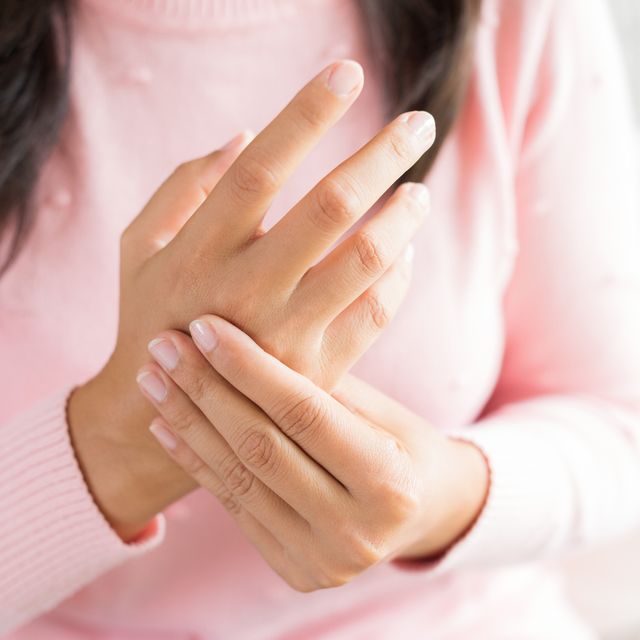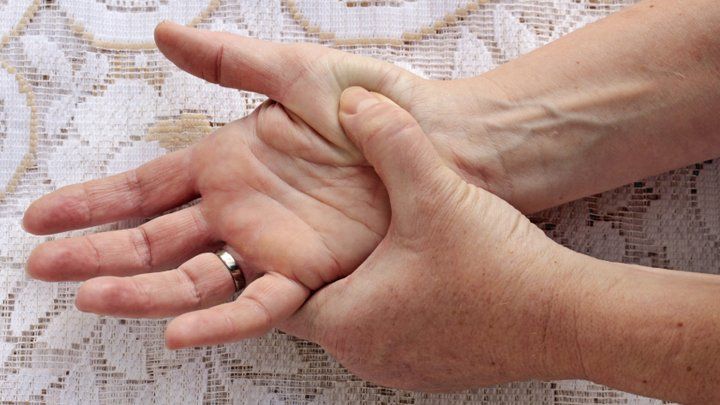With Rheumatoid Arthritis symptoms, there are times when they get worse, known as flares, and times when they get better, known as remission. Early RA tends to affect your smaller joints first. In other words, the joints that attach your fingers to your hands and your toes to your feet. As the disease progresses, Rheumatoid Arthritis symptoms often spread to the rest of your joints. This includes the wrists, knees, ankles, elbows, hips and shoulders.
Areas of the Body Affected
Symptoms That Directly Affect the Joints
Joint Pain
Persistent pain is the result of inflammation. This causes the joint to produce extra synovial joint fluid. That then puts pressure on the capsule surrounding the joint and irritates the nerve endings. RA can affect a single area of the body or multiple areas. It often feels like an intermittent, sharp pain that just doesn’t resolve. Unlike some other types of pain, patients may feel the pain whether the joints are moving or at rest.
Stiffness
A feeling of stiffness, especially after waking up in the morning or sitting for a while, is also a strong symptom of RA. Stiffness from rheumatoid arthritis can last for hours. As with pain, the stiffness can be specific to one or more joints. However, it can also be a general feeling of overall body stiffness. As the disease progresses, the stiffness can also affect ligaments and tendons. This makes it hard to bend and straighten joints like the wrist. Patients may also lose range of motion.
Swelling
Inflammation and accumulation of synovial joint fluid combine to make joints puffy and tender. When pain, tenderness, swelling, or stiffness last for six weeks or longer, it’s time to suspect RA.
Symmetry
Usually in RA, but not always, if there is pain felt in a joint on one side of the body it’s also felt in the same joint on the other side. But the degree of pain may be different on each side. The disease may progress differently on each side, as well.
Red or discolored joints
The skin over joints affected by rheumatoid arthritis may look discolored. Swollen joints may appear reddish because inflammation has caused the capillaries to widen, making more blood flow into the area.
Joints that feel warm to the touch
For the same reason that joints may look red or discolored — increased blood flow caused by inflammation — joints may also feel warm to the touch. This warmth may be present whether the skin is discolored or not.
Numbness and tingling in hands or feet
These feelings can be an early sign of RA as inflammation in the joints causes nerve compression and loss of sensation.
Nodules
These noticeable lumps may appear under the skin near affected joints — often on the hands, elbows, forearms, or knees. They can also affect other pressure points like the back of the head, the base of the spine, and the Achilles tendon. Usually not painful, in most cases rheumatic nodules move easily when touched. These bumps usually occur in more advanced RA or RA that has not been treated.
Non-Joint Symptoms of Rheumatoid Arthritis
Fatigue
Feeling more tired than usual may occur even before other rheumatoid arthritis symptoms are obvious. The fatigue is a result of systemic inflammation. It can affect people’s work life, sex drive, and everyday activities.
Disrupted sleep
When inflammation affects the nerves within the joints they can become tender to the touch. This makes even slight pressure on that part of the body painful. The pain can make it difficult for someone to get comfortable in bed, or difficult to stay asleep.
Low-grade fever and malaise
A low but chronic fever — 99 to 100 degrees Fahrenheit — is another symptom of RA. In addition, general feelings of achiness, illness, or simply feeling unwell can also occur. It can feel like the mild flu that’s not getting better. Along with fatigue, these symptoms can mimic other conditions such as chronic fatigue syndrome or fibromyalgia.
Difficulty with daily tasks
The combination of joint pain, stiffness, and fatigue can make it difficult to carry on daily activities. The overall loss of function can be extremely frustrating. Not being able to function normally and deal with daily life understandably sends many people to the doctor to find out what’s wrong.
Weight loss
Another consequence of fever, fatigue, and pain may be a loss of appetite, which can lead to weight loss.
Dry eyes and mouth
According to the Mayo Clinic, about 40 percent of people who have RA also experience symptoms that involve other parts of the body in addition to the joints. For instance, people with RA may develop the dry eyes and mouth characteristic of Sjogren’s syndrome. Your eyes may feel gritty as if sand has blown in. Lack of saliva may make swallowing difficult.
Depression and mood changes
RA and depression commonly occur together. Doctors don’t know whether depression and anxiety in people with RA are a result of the physical symptoms, or if depression is itself a symptom caused by the chronic, systemic inflammation of the disease. But doctors do know that if the depression isn’t addressed and treated, the treatment for arthritis can be less effective.

